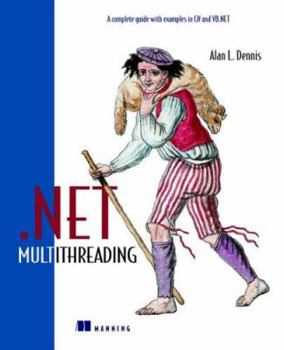Net Multithreading
With an understanding of the .NET framework, stable and robust multithreaded applications can be developed with minimal effort. Covering the topics related to multithreaded development, this book not... This description may be from another edition of this product.
Format:Paperback
Language:English
ISBN:1930110545
ISBN13:9781930110540
Release Date:January 2003
Publisher:Manning Publications
Length:360 Pages
Weight:1.40 lbs.
Dimensions:0.8" x 7.8" x 8.7"
Customer Reviews
5 ratings
Good starter for multithreading
Published by Thriftbooks.com User , 19 years ago
The book is a good starting point for multithreading. Especially helpful were the topics on wait handles and windows forms. The chapter on Designing with threads was definitely to short. I didn't like the mix of VB.Net and C#.
Amazing Work and Best to Date on this Hard Subject
Published by Thriftbooks.com User , 20 years ago
This book pulls no punches. It gives you the facts that would take years to decipher from the many of MSDN articles, and tidbits, which often contradict each other. If you are doing ANYTHING with multithreading you need this. For example, the ReaderWriterLock is often worth the extra few lines of code then the C# lock command (shorthand for the Monitor class). And you should try to never use lock(this) or lock(typeof(ClassWithStaticMember)). That is just lazy coding as you lock the entire item from ALL threads. Even when you use Microsoft's attributes under the covers, they lock the entire class! For scalable code, locks and critical sections need to be as small as possible. This book will make sure you understand what is happening and what ALL of your options are. I do not think any expert C# developer can call himself or herself an expert if they do not read this book in detail or have not gained the knowledge some other way. My only criticism (and it is a small one) is...wait.. It IS in the book and I just missed it! Never mind. I though they left out this but MANNING and the Author didn't * Synchronized contexts. You can use the SynchronizationAttribute to enable simple, automatic synchronization for ContextBoundObject objects. * Synchronized property. A few classes, such as Hashtable and Queue, provide a Synchronized property that returns a thread-safe wrapper for an instance of the class. See Collections and Synchronization (Thread Safety). * Synchronized code regions. You can use the Monitor class or compiler support for this class to synchronize only the code block that needs it, improving performance. * Manual synchronization. You can use the various synchronization objects to create your own synchronization mechanisms. The common language runtime provides a thread model in which classes fall into a number of categories that can be synchronized in a variety of different ways depending on the requirements. Anyway, I am picky as heck and this book it simply fantastic. I use many sections as interview questions for new hires. Kind Regards, Damon Carr, Chief Technologist agilefactor www.agilefactor.com
Good, but could be better
Published by Thriftbooks.com User , 20 years ago
The book gives a good explanation on .NET Threading. The problem is that the code-examples are alternated between VB.Net and C# along the book. As a C# developer, I don't like to read code in VB.Net. It made things more complicated to me. I suggest the author to release two different editions, one for each language. Or use all the code syntax in C# (which is considered the "main" .NET language).
Presuming familiarity with core computer programming basics
Published by Thriftbooks.com User , 21 years ago
.NET Multithreading by Alan L. Dennis (a computer consultant and instructor of programming at the University of Phoenix Online) is an authoritative and "learner friendly" guide to performing multithreading applications with C# .NET or VB.NET. Presuming familiarity with core computer programming basics, the informed and informative text does not require any prior knowledge or experience in multithreading. Individual chapters address the life cycles of threads, how to concurrently control them, the ThreadPool class, delegates and exceptions, multithreading in J#, and a great deal more. To put it simply, .NET Multithreading is a first-rate resource for anyone looking to improve their software's performance through multithreading, and without having to invest too much time and energy in learning the mechanics of doing so.
Good overview
Published by Thriftbooks.com User , 21 years ago
I have done a lot of Symmetric Multi-Processing (SMP) work in Win32 and I was looking for a text that would show me the classes and design patterns used to build multi-threaded applications in the .NET Framework. This book was quite good for that purpose. If I had no exposure to multi-threaded programming prior to reading this book, I still think I would have found it very useful and probably a bit more challenging. This book has plenty of C# and VB.NET examples. However, as a veteran C++ programmer, I don't read VB.NET all that well (because it looks so clunky) so I found myself wishing that each example was shown fully in both languages as some other .NET books are beginning to do. Other than that, I recommend this one for anyone who wants to build robust, multi-threaded .NET applications. The author's language and approach to the material are both very good.






